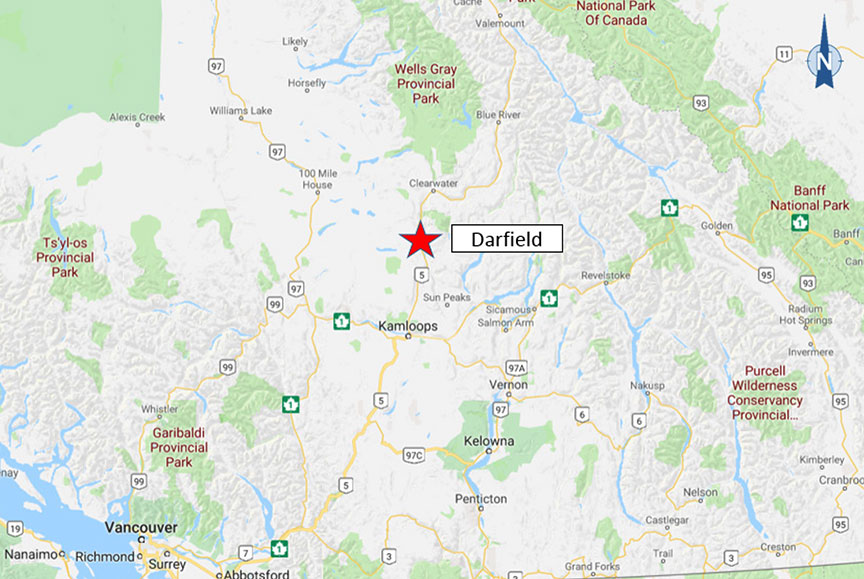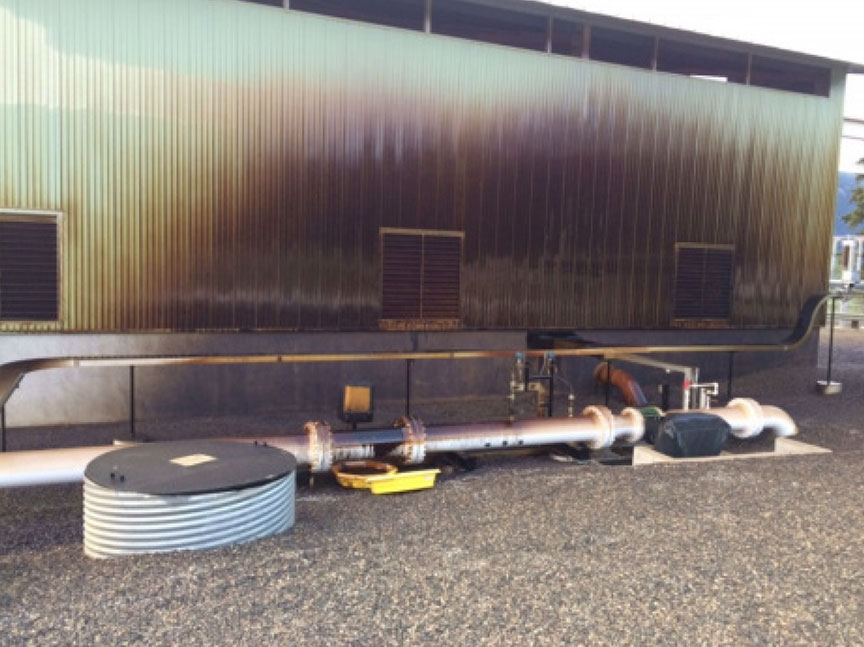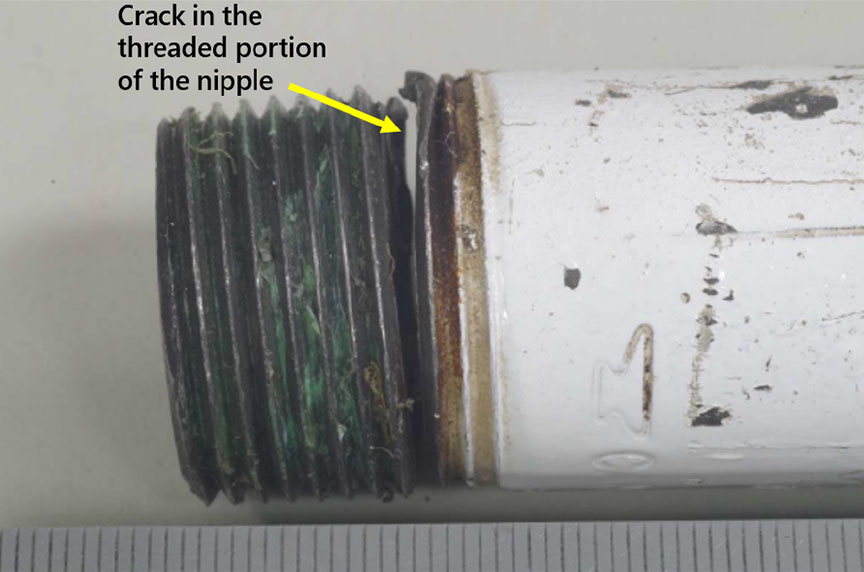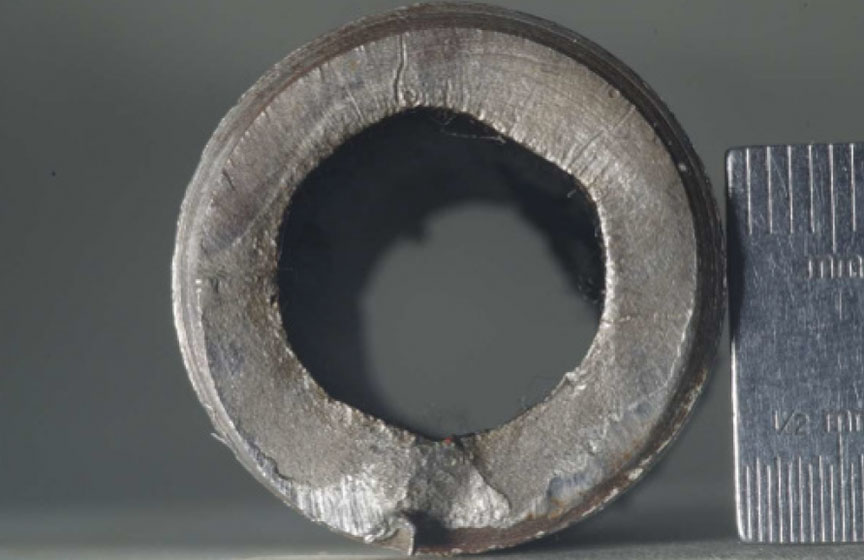Release of crude oil
Trans Mountain Pipeline ULC
Darfield Pump Station
Darfield, British Columbia
The Transportation Safety Board of Canada (TSB) investigated this occurrence for the purpose of advancing transportation safety. It is not the function of the Board to assign fault or determine civil or criminal liability. This report is not created for use in the context of legal, disciplinary or other proceedings. See Ownership and use of content. Masculine pronouns and position titles may be used to signify all genders to comply with the Canadian Transportation Accident Investigation and Safety Board Act (S.C. 1989, c. 3).
The occurrence
On 27 May 2018, at approximately 0013,Footnote 1 a release of crude oil occurred from an above-ground pipe section in Trans Mountain Pipeline ULC'sFootnote 2 (Trans Mountain) Darfield Pump Station in Darfield, British Columbia (Figure 1).
There were no injuries and no evacuation was required.
Site examination
The crude oil had released from a ¾-inch pipe nipple that was threaded into a 16-inch flow meter downstream of the main pumps at the Darfield Pump Station. The flow meter is located on a section of above-ground piping adjacent to the building that houses the pumping equipment (pump building). Approximately 4.8 m³ of product was released. Some of the released product had sprayed onto the west side of the pump building (Figure 2) and a small amount of product was found on vegetation outside the station property.
During site cleanup, about 3 m³ of product was recovered.
The Trans Mountain pipeline
The Trans Mountain pipeline, which is regulated by the National Energy Board (NEB), transports petroleum crude oil and refined petroleum products from Edmonton, Alberta, to refineries and terminals in British Columbia and the state of Washington, United States.
There are 23 pumping stations at various intervals along the pipeline. At the time of the occurrence, the pipeline, which was operating within prescribed limits, was transporting light crude oil at a flow rate of 2048 m³/h. The Darfield Pump Station's discharge pressure was 5338 kPa.
Notification of the occurrence and Trans Mountain's response to the occurrence
At 0013, Trans Mountain's control centre operator (CCO) received a low flow alarm at the Darfield Pump Station. At 0023, after confirming and reviewing the alarm, the CCO contacted an on-call field employee located near Darfield to investigate the alarm further.
At approximately 0040, a Trans Mountain security contractor who was posted at the Darfield Pump Station called Trans Mountain to report that there was a hydrocarbon odour at the station and that a mist of crude oil had sprayed on one side of the station's pump building.
At 0046, after confirming the product release with the security contractor, the CCO initiated a controlled shutdown of the Trans Mountain pipeline, which included a shutdown of the Darfield Pump Station.
The pipeline was out of service for about 15 hours.
Site remediation
Site remediation started later that day. Surficial soils and all accessible saturated subsoil affected by the released product were excavated and disposed of at an appropriate disposal facility. The affected vegetation off company property was cut and disposed of appropriately.
Soil samples from the adjacent property in the area where vegetation had been affected were collected for testing. The soil test results met the applicable regulatory criteria, confirming that no offsite impacts remained.
Starting in June 2018 and throughout the rest of the year, the remaining on-site subsoil that was inaccessible owing to the site's infrastructure was treated in place using bio-remediation, that is, nutrients are injected into the sub-surface to help hydrocarbons to degrade. Monitoring of this subsoil will continue for the next several years. Additional groundwater monitoring wells were installed to monitor for potential impacts to the groundwater resulting from the release.
Flow meter
The flow meter is of the wedge type and operates by creating a pressure differential across a restricting element (wedge).Footnote 3 Small-diameter pressure taps are located upstream and downstream of the wedge at approximately 90° relative to the top of the meter.Footnote 4 These taps are used to measure the pressures in order to calculate the flow. The ¾-inch pipe nipple that failed had been installed in 2009. It was threaded into the pressure tap component of the flow meter that was upstream.
Metallurgical analysis of pipe nipple
The spool piece,Footnote 5 including the ¾-inch pipe nipple from which the oil was leaking, was removed and sent by Trans Mountain to a laboratory for detailed examination (Figure 3). Ratchet and beach marks were present on the fracture surfaces of the threaded portion of the nipple. It was determined that the threaded fitting had cracked due to fatigue (Figure 4).
The crack had started at the last engaged thread of the nipple, a location known to have a high stress concentration. The location of the pressure taps on each side of the flow meter would have subjected the pipe nipple to additional bending forces. The high stress concentration on the threads combined with the additional bending forces likely led to the vibration-induced fatigue failure of the nipple.
Facility Integrity Management Program
Trans Mountain's Facility Integrity Management ProgramFootnote 6 includes provisions to identify, assess, document, and address hazards within each facility. As part of this program, a risk assessment is conducted annually and a qualitative risk assessment (QRA) is conducted every 3 years.
The annual risk assessment, which is conducted in accordance with the company's Integrated Safety and Loss Management System, includes a review of all known facility integrity hazards and any recently identified facility integrity hazards. This assessment takes into account all identified control measures to determine the risk associated with each identified hazard. The most recent risk assessment had been conducted in November 2017.
The QRA includes the assessment of each hazard to determine whether adequate preventive and mitigating control measures are in place to manage the risks. Trans Mountain requires that each control measure be properly implemented, maintained, and documented. The 2 most recent QRAs had been conducted in 2013 and 2016.
At the Darfield Pump Station, the hazards associated with pumps, sump tanks, and facility piping (including small-diameter piping) had been identified. With respect to small-diameter piping, the potential hazards related to vibration affecting threaded connections were documented in the QRA. The applicable control measures (engineering and/or procedural) had been implemented to address fatigue failure. However, the specific effect of additional external loads and stresses on small-diameter pipe components, such as bending stresses when such components are installed at a 90° angle, had not been considered.
Regulatory requirements for managing hazards and risks
The NEB requires the pipeline companies it regulates to anticipate, prevent, mitigate, and manage any hazards and risks associated with their operations. The NEB uses audits and inspections as key tools to verify whether companies under its jurisdiction are complying with the applicable regulatory provisions. A risk-based model is used to assess regulated companies and their facilities to determine the appropriate activities for verifying compliance.
The NEB had conducted a management program audit at Trans Mountain in February 2009. This included a comprehensive review of the company's integrity, damage prevention, health, safety, and environmental protection programs. Its final report, issued in March 2010, noted a number of instances of non-compliance with Trans Mountain's system-wide proactive approach to identifying hazards. Trans Mountain later submitted a corrective action plan, which the NEB approved. In February 2014, the NEB accepted the corrective actions that had been implemented and closed the audit.
In May 2015, the NEB conducted an inspection at the Darfield Pump Station. This inspection did not find any non-compliance issues related to Trans Mountain's Integrity Management Program.
Actions taken by Trans Mountain
Following the occurrence, Trans Mountain developed a revised configuration design for piping associated with flow meters. This revised configuration is intended to reduce the effects of bending loads that can contribute to vibration-induced fatigue at small-diameter threaded connections. The revised configuration was applied at the Darfield Pump Station.
Trans Mountain conducted inspections of all wedge flow meters and associated piping nipples across the Trans Mountain pipeline. From these inspections, Trans Mountain identified nipples at 4 other pump stations that had a similar configuration to that of the Darfield Pump Station at the time of the occurrence. These nipples were replaced using the revised configuration design. Also, Trans Mountain initiated a system-wide inspection at other installations to identify and address situations where threaded connections are subjected to bending loads and vibrations.
Safety message
In order to manage the risk of vibration-induced fatigue failures effectively, a pipeline company's integrity management program must identify and mitigate hazards related to vibration, including additional external loads and stresses, particularly for small-diameter threaded connections.
This concludes the TSB's limited-scope investigation into this occurrence. The Board authorized the release of this investigation report on . It was officially released on .



